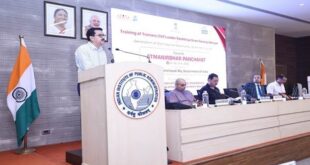- To begin with, elections divide voters into a dubious majority and a minority. The majority-minority division of 50% plus one and 50% minus one is, in principle, hardly a decisive mandate even as this is treated as one empirically.
- But the practice of elections belies even this notion of “majority”; there is hardly a government anywhere in the world and at any time that governs through a majority of the mandate.
- Usually, 30% to 40% of the votes cast give a party a comfortable majority to rule legitimately.
- This is structured into multi-party elections through “the first past the post” principle; but even in a system such as the United States, Donald Trump could defeat Hillary Clinton even as she received some 2.5 million more popular votes than him, in 2016.
- In practice again, contrary to theory, even as the voter is all alone in the polling booth voting as an untrammelled individual, her/his vote is still conditioned by numerous demands on it by family, community, religion, culture, and, above all, by the political alternatives offered by political parties.
- A loss of individuality is implicated here. The individual does not create the choices which are given by parties, very often wrapped in false propaganda and even more false promises. The individual has the “freedom” to choose one or another of these.
- The complete equation of democracy with electoral politics draws one’s attention away from any alternative form of governance. There is no space here for diversity.
A reinforcement of identities
- This democracy came to India in its most modern form: unconditional adult franchise and multi-party periodic elections.
- Yet, the operative categories of electoral politics here have mostly been pre-modern: identity politics of caste, sub-caste, community, region, language, etc.
- Not long ago we were familiar with acronyms such as AJGAR (Ahir, Jat, Gurjar and Rajput castes) and MY (Muslims and Yadavs) and so on, signifying the vote base of different political parties, or what came to be picturesquely called the ‘vote bank’.
- Jawaharlal Nehru had hoped that education and the experience of democracy would force a retreat on these operative categories and generate a more “modern” consciousness among the masses.
- What has emerged is contrary to this. The very success of these mobilisations has reinforced identities instead of weakening them.
- The Bharatiya Janata Party is determined to create the biggest vote bank which would be ever hard to defeat: the entire Hindu population, comprising 80% of the populace.
- It can afford to marginalise and thus disenfranchise all others in the residual 20%. So, as long as we practise this form of democracy, its fault lines and, above all, its link with capitalism will remain unbroken.
- Yet, the fact that humanity has throughout history sought one or another form of social equality keeps the possibility of this urge erupting yet again more amenable to achieving a reality that has eluded us so far.
- What its form and its grade of success will be are hard to guess. What can be said confidently is that history is still unfolding and creating a future for us
SOURCE: THE HINDU, THE ECONOMIC TIMES, PIB
 Chinmaya IAS Academy – Current Affairs Chinmaya IAS Academy – Current Affairs
Chinmaya IAS Academy – Current Affairs Chinmaya IAS Academy – Current Affairs



